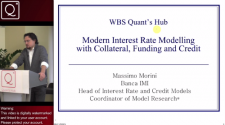Workshop view
Back to Shop
FX Option Performance: Long Term Anomalies, Opportunities and Hedging Strategies
Running Times:
Part 1 - 1hr 7mins
Part 2 - 1hr 29mins
Part 3 - 52mins
Part 4 - 51mins
Outline: Why take this course?
Another course on FX options? But surely there are plenty of courses and books which tell you how to price and hedge these products? Indeed there are – but that’s not what this is for. On this course you will learn about the value, not the price, of FX options.
The FX Option market has grown from humble beginnings in the 1980s to a global behemoth, with hundreds of billions of US dollars worth of flow going through it each trading day. With such size and liquidity, it is generally assumed to be efficient, with few profit opportunities. But astonishingly, this is not so. Jessica James, the course leader, presents new work where she has taken a completely different attitude to most option studies; instead of looking into the theory of how the products are valued and what they should be worth, she has gone back through the historical data to find out what they actually delivered compared to what they cost.
This course thus offers a unique and practical guide to option trading and hedging, having the courage to report how much these contracts have really made or lost. This critical (and often overlooked) information gives investors and hedgers alike the edge they need to make more informed decisions. Presented in accessible terms and not overly technical, with over a hundred charts and diagrams to illustrate the findings, this course should appeal to anyone with an interest in the area. Jessica reveals where to look for value and offers help to corporations hedging their FX exposures. Some of the results are truly remarkable; for example, longer dated call options pay back on average only about half of their initial cost. It seems astonishing that this information is not public knowledge.
The course will be a fascinating introduction for students entering the field, a source of exciting ideas for investors looking for opportunities, and an essential guide for corporations wondering how to hedge their FX exposures.
‘The FX Option Market: How it works, what’s right, and what’s wrong’
Part 1) Introduction to the FX option market
- History of theory and trading
- Market Participants
- What they are, why buy or sell them
- How to price them
- Black-Scholes-Merton
- Limitations of this classical model
- The underlyings (FX rates, depos, forwards, vols) and how they behave. (correlation of underlyings, implied vs realised quantities)
- How they affect the price of options – lots of market examples, EURCHF will be fun
- The ‘greeks’
- How options are traded
- By a hedger
- By a hedge fund
- By a trading desk
Part 2) What’s wrong with the market: Puts vs Calls
- What’s the ‘fair price’ for an option?
- Backtesting FX option returns – theory, data, difficulties
- How might mispricings arise?
- Broad brush results: straddles
- Puts vs calls: first sign that something is wrong
- Individual ccy results – clues to what is happening with AUD, JPY
- Explanation and theory of the carry problem
- Implications for hedgers
- Trading strategies
‘The FX Option Market: Long term anomalies and how to use them for trading and hedging’
Part 3) What’s wrong with the market: ATMF vs OTM options, G10 vs EM
- Theory of OTM options – volatility smile
- Data available (risk reversals and butterflies) and what does it mean
- Illustration that OTM options are poor value
- Detailed discussion as to how/why
- Differences with G10 and EM
- ATMF
- OTM
- With tenor
- Theory of differences
- Currency-by-currency discussion
- Trading strategies
Part 4) The FX Carry Trade
- History
- Theory
- Improvements/enhancements. How to reduce risk and improve returns
- Can we do it with options?
- Trading strategies
Academic level
Topic
FinancePublished date
13 July 2015Price
£199.00Related workshops

Marco Bianchetti
Interest Rate Modelling: Modern Interest Rates with Collateral, Funding and Credit Risk (Part 1)
19 February 2014
Massimo Morini
Interest Rate Modelling: Modern Interest Rate Modelling with Collateral, Funding and Credit (Part 2)
4 March 2014





